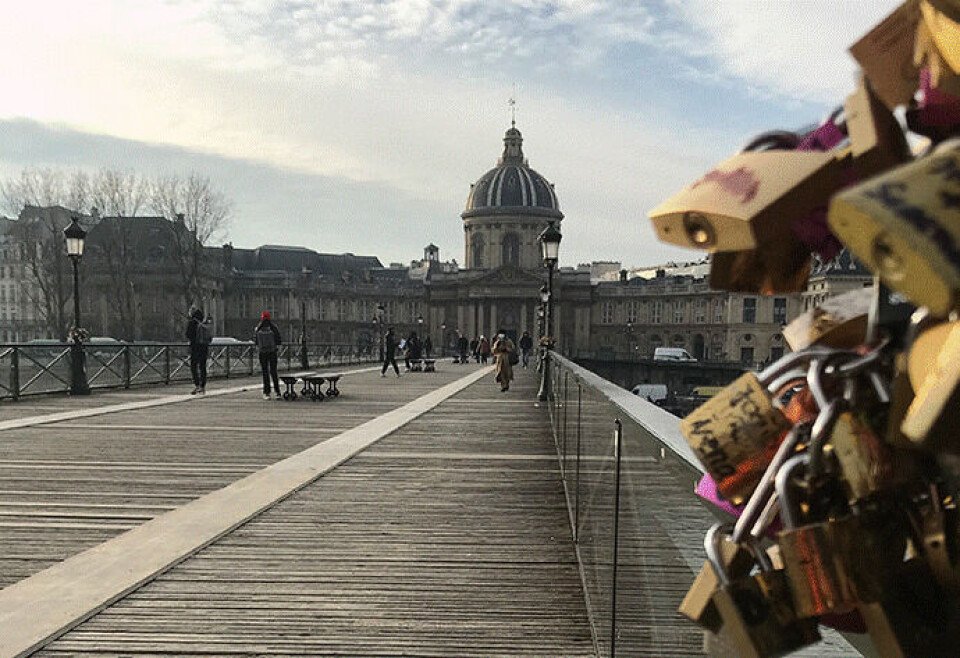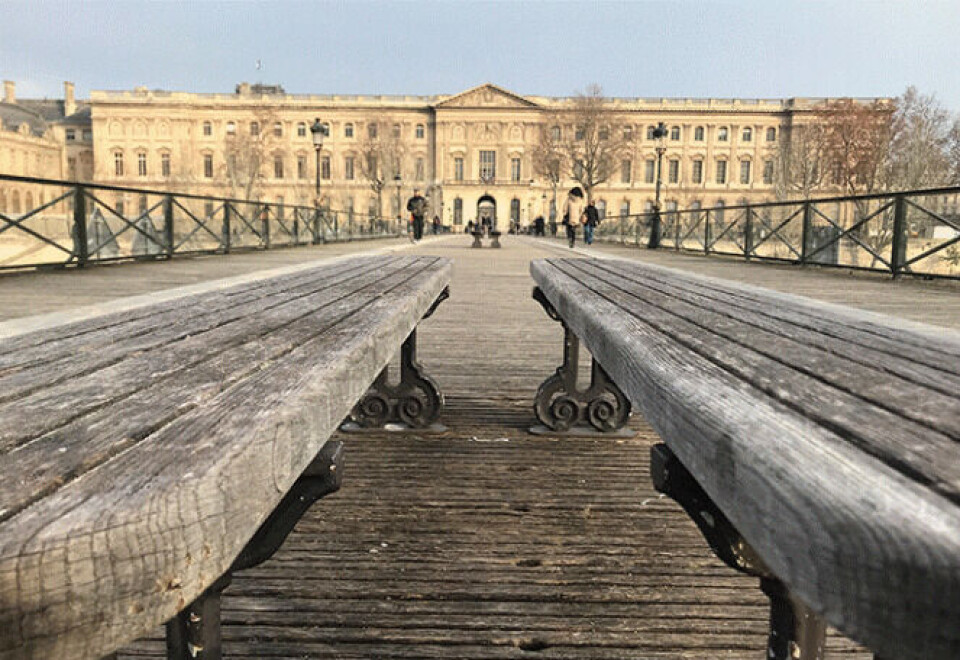-
Paris metro station Villejuif-Gustave Roussy named world’s most beautiful
International architecture award supported by Unesco given to stop on metro line 14
-
Five iconic French dishes from different regions
Explore the rich culinary heritage of France with these traditional dishes, from cassoulet in Occitanie to cari poule in La Réunion, showcasing the country's geographic and cultural diversity
-
Commuter boat service planned for Paris
‘River metro’ could soon become a reality on the Seine
Paris’s ‘Love Lock Bridge’ closed for repairs but won’t deter couples
Pont des Arts, which once partially collapsed under the weight of padlocks, is to have rotten planks replaced in the latest chapter of its fascinating history

Paris’s Pont des Arts is finally set to undergo repair work on decaying wooden planks after a series of delays and growing pressure from Parisians.
Locals had gathered behind social media hashtags to denounce the city’s overall lack of restoration of public areas.
Read more: 100 French sites chosen for restoration in annual ‘heritage mission’
In the short term, it means no more crossings from Quai Malaquais or Quai de Conti in the 11th arrondissement to François-Mitterrand and Louvre quays on the right bank of the Seine.

It also marks another chapter in the bridge’s fascinating history.
Pont des Arts was France’s first major iron bridge and just the third worldwide after Iron Bridge (1781) and Wearmouth Bridge (1796) in the UK.
It was immortalised in the 1932 French film Boudu sauvé des eaux (Boudu Saved From Drowning), directed by Jean Renoir, in which Boudu, a tramp, is rescued from a suicidal plunge from the bridge into the River Seine.
The original crossing was replaced by an almost identical structure in the 1980s. It had been damaged by aerial bombardments during the world wars before suffering a collapse when it was rammed by a barge in 1979.
Padlock trend begins
The new bridge became one of Paris’s most popular after tourists started attaching padlocks with their names on to the railings and then throwing the keys into the river below as a romantic gesture.
Read more: PHOTOS: See the 14 places vying to be France’s most loved monument
It has also inspired countless artists, been the setting for various commercials, movies and TV shows, and lent its name to tourism firms offering visits to the site.
“It is Paris’s most beautiful bridge,” insists Hendrikje Ter Vehn, director of one such company, in response to why his organisation took its name.
The original bridge was commissioned by the government of Napoleon Bonaparte in a decree of 1801 to provide passage between the Louvre and the Collège des QuatreNations (now the Institut de France).
It was named after the Palais des Arts, now the Louvre.
Design questioned by Napoleon
Its design was questioned by architects and Napoleon himself at the time, for its perceived ugliness, lack of solidity and narrowness, which was seen as a potential hindrance to river commerce.
The Fondation Napoléon reports the emperor complained: “It does not appear to be robust. This bridge is nowhere near spectacular. I understand Great Britain uses iron to build wide-dimensional bridges since it lacks stone, but here in France where everything abounds…”
Nevertheless, construction went ahead under the engineers Louis-Alexandre de Cessart and Jacques Dillon.
The cast-iron crossing was inaugurated on November 24, 1803, when 64,000 Parisians strolled over its timber decking shouldered by nine arches.
It then averaged around 11,000 people per day, a considerable number in the early 19th century, and was adorned with hanging baskets of flowers and benches for tired flâneurs.
One report of the bridge’s inauguration said: “The air is refreshed by that of the Seine and embalmed by perfumes of heliotrope, roses, reseda, jasmine and orange blossom water.”
It compared the Pont des Arts to “a garden suspended above water”.
Eventual collapse
In 1977 the bridge was closed to pedestrians, ahead of its eventual collapse.
Former president and then-mayor of Paris Jacques Chirac inaugurated the new Pont des Arts in 1984 after three years of construction.
It has only seven arches spanning the river instead of the original nine, and these are made with steel, rather than cast iron.
Since then, Pont des Arts has become integral to Paris’s reputation as the city of love, and the structure was nicknamed ‘Love Lock Bridge’ in response to the padlock trend.
Several Connexion readers, as well as Barack and Michelle Obama, pictured, who visited Paris in 2009, are said to be among nearly one million couples who put locks on the bridge.

The sheer weight of these, estimated at around 45 tons, caused a section of railing to collapse in 2014 and compelled the city to step in and start removing the locks.
Creative repurposing of removed locks
They were repurposed in a range of creative ways.
Some 10 tons were auctioned to raise money for associations helping refugees.
Other locks were turned into a 3m-tall house by Franco-Mexican artist Carmen Mariscal during an exhibition at Paris’s Palais Royal in 2020.
One man, who could not countenance so many padlocks getting thrown away, embarked on a year-long quest to unlock 800 of them to return to lovers. “I put all my heart into that project,” said Philéas Le Cléateur.
His story received international coverage and he even claims to have found the Obamas’ padlock, engraved with the words “Michelle and Barack, love forever” on one side and, on the back, “20 years” and the date 2009.
Unfortunately, its provenance will remain a mystery: Mr Le Cléateur never got confirmation from the White House press team despite repeated efforts to get in touch, leading him to question whether the couple had been impersonated.
Desire to reunite lovers and locks genuine
His desire to reunite lovers with their locks is genuine, he insisted, and not an elaborate publicity stunt.
He was inspired after being contacted by a Chinese couple who had heard of the removal plan and who requested that he try to find theirs.
He never did.
Only a handful of locks have been traced to date and sent back to their owners, he said.
His favourite lock features the name Patricia Barnes with her birth and death dates, a lock he suspects was attached by family members in tribute after she died.
Mr Le Cléateur said the padlock trend exploded between 2013 and 2014 as a result of tour operators including the activity in their trips.
Glass panels have now replaced the traditional railings and wire fencing on Pont des Arts to prevent amorous couples attaching padlocks.
The tradition has not died out, despite Paris authorities regularly ordering their removal from various sites around the city.
The Pont de l’Archevêché and fences in Montmartre are two spots where brand new lovers have locked fresher romances.
The Pont des Arts has not been entirely forgotten either.
Some people have begun encircling its street lamps with bicycle locks and couples have once again attached lovers’ locks on these.

Related articles
The Paris suburb housing estate that is like no other in France
Heritage days: How to find out what is on in your area of France
Fondation du patrimoine saves 35,000 buildings in France in 25 years
























